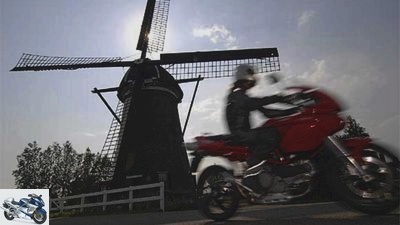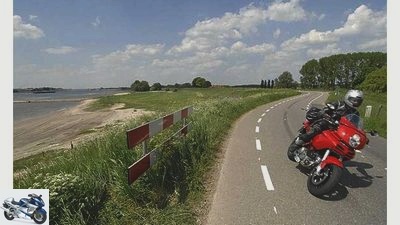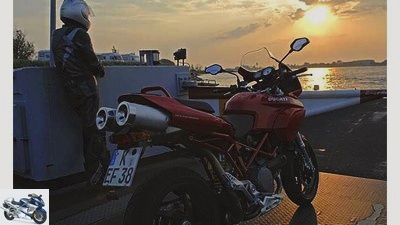Table of contents

Daams
to travel
On the move: Holland
On the move: Holland
Dutch levees
Winding motorcycle lanes in the pancake plate Holland, even at lofty heights? Why, surely! On the dikes of the Rhine, Waal and Lek between Emmerich and Rotterdam. Really delicious.
Klaus H. Daams
06/04/2009
Rolf and I meet, as we did 20 years ago, early in the morning at 9 a.m. at Klingel-Willy, one of the first free refueling stations in Kleve at the time. Where the fuel was cheap, but the octane rating was a lottery game. Well, a lot of water has flowed down the Rhine since then. The colleague from common Guzzi Le Mans times is now driving GSX-R 1000 K3. Before we get stuck, the keys have to be exchanged. The new Ducatisto now has the opportunity to use the Multistrada 1100 S to find out more about the latest Italian two-cylinder products. Which leads to a jerky “You can hang pictures with the gearbox at about the third red light, it is so hooked”. Where do we actually want to go? To the North Sea, always accompanied by Father Rhine and his floods, which mix with the sea near Rotterdam. Which are lined with dikes, on which you can curve surprisingly smoothly through and over the country.
Kleve, Schwanenburg, cattle (Josef Beuys’ nursery), the Duffelt, black and white cows, sixth gear – Germany disappears in the rearview mirror. In Millingen aan de Rijn it’s all about Holland. The old border house is in a deep slumber, holiday mood from the first meter. Heineken instead of Diebels, decorative anchors in the front gardens instead of wagons like in the Ruhr area. A tip: In the “Cafeteria De Smulpaap” (open from 12 noon) there are Ras fries, a specialty made from potato dough that looks like spaghetti ice cream. One could talk for hours about all the conspicuous little things. Or just turn right to the landing point for the pedestrian ferry to Lobith, drive up onto the dike. Whoa, we’re already entering a world of our own. The pale blue of the sky, only separated by a narrow green line, merges into that of the water. Unlimited space. On the river, just as an example, a paddler with a sun hat and a container ship from Yang Ming, a shipping company from Taiwan. On the other side of the street basking through the grass of the embankment is a modest church next to a handful of houses. This is what love at first sight can be. And the last one on our good old Rhine. It forks right after Millingen into the narrow Pannerdens Kanaal and the Waal, which transports around two thirds of the amount of water – along with most of the ships – to the North Sea. We are now following the Waal as a double fleet.
There are three things to keep in mind. First, Fietsers, the local cyclists; They love to socialize next to each other, are practically under nature protection and must never be honked to the side in the interests of peaceful coexistence. Second, Drempels, small, mean jumps on the street; they are said to have a traffic-calming effect and have cracked some intervertebral discs. Thirdly, although all the dikes lead to Rotterdam, the motorized traffic is sometimes diverted or diverted, for example in Keekerdom. At the entrance to the 600-soul nest, turn right, across red brick pavement to the Duffeltdijk and the village church, which, unique in Holland, stands in front of the dike and thus becomes Noah’s Ark when the water floods. At least one aircraft carrier would be needed for the 200,000 Siberian wild geese that come to the Lower Rhine for the winter and feed themselves with fat for their return journey. Beavers, stilts and black-headed gull colonies around the Kaliwaal quarry pond, on which a display board provides information about flora and fauna, light up the eyes of nature lovers all year round. Of course, only if you bring the motorcycle to a standstill on the winding track in its element. Which is not easy given the driving pleasure.
About half a kilometer after the lake, turn right into Erlecomsedam, a B-road for vehicles up to two meters wide. The space that the river has here in its floodplain is downright wasteful. He thanks it not only with fertile pastures, but also with loamy raw material for bricks, which are baked in the many “Backsteenfabrieken” of the region. The Dutch language is always good for translation practice. Unfortunately, it was sacrificed to the Grand Latinum at the time, so that today it is at best enough for something like the caution warning traffic sign “Vaart reduce, sparse children”. Only twelve kilometers on the clock since the border near Millingen, and already a cake break? Necessarily. In the enchanting “Huiskamercafe Oortjeshekken” on the Bisonbaai. The temptation to watch the day pass by with Appelgebak and other delicacies, to ask for a “Kamer met uitzicht op de rivier” for the night as a precaution, is quite great. To cool down, maybe a hop on the other side of the dike, where a “Zwemplaats” invites you to swim.

Daams
It is not at all true that the Dutch can play football well but cannot drive a car.
You can immerse yourself deeply in Dutch nightlife in Nijmegen, the country’s oldest city, which has its origins in the Roman settlement Noviomagnus and today, thanks to the university – and probably also because of its colonial past, keyword Suriname – has an enviable disco and bar scene . But even during the day it is great (and shops or flea markets) in the midst of cosmopolitan diversity, for example on the market square between the old city scales and the St. Stevenskerk. The hustle and bustle on the Waalkade, a promenade right on the water with a large motorcycle parking lot, is not quite as hustle and bustle. But we should go on now, so that the idea of maybe briefly boarding the “Pannenkoekenboot” moored on the bank is nipped in the bud as a precaution. Over the Waalbrucke in the direction of Arnhem, then immediately down the first exit and in Lent right onto the Oosterhoutsedijk. It’s good that it’s not Saturday or Sunday, because then from 10 a.m. to 6 p.m. only Fietsers, but not cars and motorcycles, are allowed to use the following route. Oh, you could cut a piece of the cloudy sky water forest curve dyke landscape and take it home with you. If Rembrandt and Co. had already known Ducs and Suzis – the machines would surely have been immortalized on many an oil painting. All that remains is the fleeting, at the same time intense and unforgettable pleasure of the permanent change of angle and perspective.
Paradigm Shift in Doodeward. Like a cube-shaped whim of nature, a nuclear power plant lies directly on the dike; the plant was taken off the grid in 1997 and has to “fade away” for another 40 years before the radioactive parts can be sucked up in any form and everything can be turned back into a green field. The “Scheepswerf Doodeward” reacts more quickly to the signs of the times. There they are getting to grips with the freighter “Deo Juvante” on the shipyard’s operating table, not necessarily with God’s help, but with a cutting torch and welding machine. In the past, many a boat was cut out five meters at great expense in order to be able to sail less – and thus cheaper – with one man crew in accordance with regulations, today ships are often lengthened to load 500 tonnes more – and receive the corresponding subsidies. Those who already have their sheep in the dry: folding chairs, ‘ne krant (newspaper) and a kopje koffie from the thermos – the happiness of retirees on the banks of the Waal is ready. Ships with a whirling screw jet push themselves past the box seat almost with a suction fit. When we watch the waves glitter in the backlight, we are hungry. The “Eethuisje de Veerstoep” in Ochten arrives as ordered, a french fries palace with everything fast-food gourmets could wish for. For example, special fries: with ketchup, majo and raw onions. Smakelig eten, bon appetite.
Another specialty are bromfietsen and knallertjes, onomatopoeic mopeds and mopeds. 15-year-old Denis from Ochten drives a splendid example. The souped-up 70s Puch, which is wheelie-capable from 20 km / h, has a whopping ten horsepower, as long as the pilot shifts his weight extremely far back. Prins-Willem-Alexander-Brucke, Prins-Bernhard-Schleuse and the jam town of Tiel ensure a dike-free interlude before Ophemert heads back up to the Belle Etage. We are now strolling through the Betuwe fruit-growing region, a sea of flowers in spring and a paradise for strawberry and cherry lovers in late summer. And if you like the aroma of river water, and prefer to take a ferry than over bridges, you can have yourself crossed between Brakel and Herwijnen on rocking planks. A feast for romantics, especially in the evening, when the Waal looks like someone has poured barrels of gold into it.

Daams
Ferry romance between Brakel and Herwijnen.
At 9.15 pm the first glasses of Hertog-Jan beer finally light up on the terrace of the “Hotel‘ t Veerhuis ”in Wamel. When looking at the menu, you can choose between Waterbewoners and Landlopers. Quacked to sleep by frogs instead of a Philips television, you may dream of the last flood in 1995, before the combine harvesters wake you up in the morning and the anticipation of Hagelslag (chocolate sprinkles) for breakfast drives you. As fast as the wind we drive our “mills” further west, where a whole armada of typical four-winged birds patiently waits for visitors. So don’t snap the memory card full at the first windmill. But still stop every now and then, for example at doll-like houses that crouch behind the dykes like water-shy cats, so that only the thick “fur back” peeks out, the thatched roof. To ensure that such idylls are also safe in the future, the dikes are occasionally raised and their crowns reinforced. Not to forget the danger lurking downstream: storm surges can push half of the North Sea inland. In order to prevent tragedies like that of 1953 (1,835 deaths) or even that of 1287 (50,000 deaths), the frayed coast was sealed off with a system of huge steel slides that can be closed if necessary. However, there is hardly any space under the helmet for disaster scenarios on a blissful May day. One thinks much better of the Irish Sea when memories of Kirk Michael and the Isle of Man are awakened in Kerkeneind with a jagged panning around the little church; especially when a 125cc Aprilia Chesterfield approaches and takes off on the Drempel jump hill like on the Ballaugh Bridge.
From Gorinchem, Rotterdam casts its shadow with dense settlements. So escape into the terrain, across the country towards Alblasserdam through the contemplative world of water lilies and duckweed, boats and canals. It is polderland, once drained by windmills that did not grind grain, but pumped the water out of swamps and lakes by means of their paddle wheels, which were driven by early “green electricity”. 19 of these technical marvels – until the invention of the steam engine, the largest energy producers in the world – are in Kinderdijk, the proverbial mill Manhattan of the Netherlands. Two hours later we are rolling through the port area of Hoek van Holland. Here the England ferry to Harwich sets sail, probably a few drops of Rhine water under the keel. Because this is where the river flows, which originated 1320 kilometers ago in the Alps and was renamed the Nieuwe Waterweg on its last stage. Where this journey could end – if it weren’t for that part of the Rhine that bids farewell to the north as Pannerden’s Kanaal near Millingen and finally – after a metamorphosis first into the Neder Rijn, then the Lek – reunites with the Waal at Kinderdijk. It’s now back on that, again up on the dike.
There, too, the nautical element is not neglected, on the contrary. At Ameide (ver) an asphalt ramp leads down from the dike to a sandy bay. Who can resist? The Multi-strada also wants to play on the beach, which, according to its namesake, is suitable for many streets. Also for waterways? First everything goes well, then suddenly nothing at all. The Belladonna digs its way up to the axis, then another ship comes by and with it high waves – pretty nasty. Well, Pirelli Scorpions are not a Conti TKC 80. No chance to pull the motorcycle out, the silt holds it tight like an octopus. A multistrada in distress. Small consolation: it stands as if it were set in concrete and cannot tip over. A lady who leads her Golden Retriever to splash around has the saving tip: There is a trekker workshop nearby that can definitely help. Which, thankfully, she also does, with a tractor, belts and then even a steam jet. Somebody complains again about the German-Dutch relationship.
After this nautical aha experience, the rest of the tour is quite leisurely. At Beusichem, ships push their way past cows through flower-filled meadows. In Maurik you will be amazed by a lock and wild water skiers, a little later you can rent boats at a campsite “Bootjes te huur”. Shortly before Rhenen, wooded hills are a reminder that Holland means woodland. Between Opheusden and Heteren you can roast your tires (in the Lower Rhine for easy). In Arnhem, you can quench your thirst for education in the “Nederlands Watermuseum” or open a new barrel: follow the IJssel, which branches off from the Pannerdens Kanaal, north to and around the IJsselmeer. We content ourselves with a three-fold portion of Rolf’s favorite dike near Doornenburg, nicely arranged with great curves and a fine surface; from here it’s not far to Lent near Nijmegen, you remember? For one euro, a yaw ferry crosses over to Pannerden, previously only driven by the current, today supported by an auxiliary motor. In Tolkamer we finally enjoy satay skewers from “Marielle” and see each other really fed up on the Rhine promenade, from the mighty four-person pushers as well as from floating hotels from Switzerland. Then via Spijk, past the Daams brickworks, to the green border near Emmerich – and we’re as good as home again.
Related articles
-
On the move: through California by motorcycle
Henniges 18th pictures Henniges 1/18 An adventure-hungry editor and companion in search of the American dream. Henniges 2/18 Intersections in the USA:…
-
On the move with the BMW R 90 S, Moto Guzzi Le Mans and Triumph Bonneville
Rein van der Zee 13th pictures Rein van der Zee 1/13 Top and bottom: At Saint-Martin, a narrow hanging structure spans the Ardèche. This is where the…
-
On the move: Madrid and its sierras
Daams to travel On the move: Madrid and its sierras MOTORCYCLE On the go Madrid and its sierras They are not exactly around the corner, but are worth the…
-
On the move: Spain from north to south
Deleker 15th pictures Deleker 1/15 With the motorcycle across Spain, a trip with many highlights. Deleker 2/15 Ready for a movie: Spain’s castles are…
-
Starflite Batavus motorcycles from Holland
Siemer 21 pictures Siemer 1/21 We visited two insiders on Batavus motorized bikes. Here on the road with Starflite GT 50 and Batavus ILO 125. Siemer 2/21…
-
On the move: Hercules K 50 SE, Kreidler Florett RS
Sdun motorcycles On the move: Hercules K 50 SE, Kreidler Florett RS On the move: Hercules K 50 SE, Kreidler Florett RS Performance race Content of In…
-
On the move: around the Mediterranean
shepherd 30th pictures shepherd 1/30 Ummayden Mosque in Damascus. shepherd 2/30 Snail shells mark extinct life in the Libyan desert. shepherd 3/30 Old…
-
On the move with BSA Rocket Gold Star replica
Fred Siemer 8th pictures Siemer 1/8 BSA Rocket Gold Star replica Siemer 2/8 BSA Rocket Gold Star replica Siemer 3/8 Characteristic: The Siamese manifold…
-
On the move: 250cc from Kawasaki, Suzuki and Yamaha
Jahn 45 pictures Jahn 1/45 Jahn 2/45 Reminisce: For many, a 250cc two-stroke was the first real motorcycle in the 70s. Jahn 3/45 Jahn 4/45 Jahn 5/45 Jahn…
-
Safe on the move with semi-active chassis from ZF
BMW 7th pictures BMW 1/7 This is how potholes can disappear: The semi-active chassis system from ZF brings more calm to the motorcycle set-up, and thus…